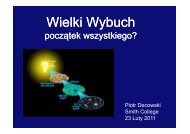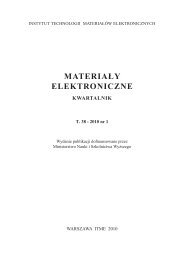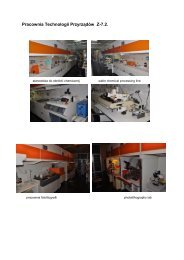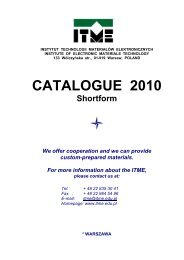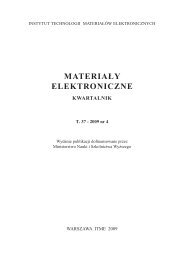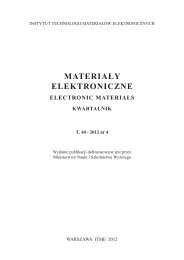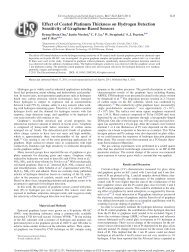MATERIAÅY ELEKTRONICZNE - ITME
MATERIAÅY ELEKTRONICZNE - ITME
MATERIAÅY ELEKTRONICZNE - ITME
You also want an ePaper? Increase the reach of your titles
YUMPU automatically turns print PDFs into web optimized ePapers that Google loves.
Deep-level defects in epitaxial 4H-SiC irradiated...<br />
center concentration in the both epilayers is found<br />
to be nearly by three orders o magnitude.<br />
Fig. 5. Concentrations of deep-level defects detected in<br />
the epilayers A (left) and B (right) with the nitrogen concentrations<br />
of 1.1×10 15 cm -3 and 4.0×10 15 cm -3 , respectively,<br />
after irradiation with a dose of 1.0×10 17 cm -2 of<br />
300-keV electrons.<br />
Rys. 5. Ilustracja graficzna wartości koncentracji głębokich<br />
centrów defektowych, wykrytych w warstwach<br />
epitaksjalnych z grupy A oraz z grupy B po napromieniowaniu<br />
dawką elektronów o energii 300 keV, równą<br />
1,0 x 10 17 cm -2 . Koncentracja azotu w warstwach wynosi<br />
odpowiednio 1.1 x 10 15 cm -3 i 4.0 x 10 15 cm -3 .<br />
In view of the results obtained by measurements<br />
of the positron lifetimes [15], C atoms are predominantly<br />
displaced when irradiated with low energy<br />
(300 keV) electrons, giving rise to Frenkel pairs:<br />
V C<br />
and C i<br />
. Silicon atoms can be displaced at higher<br />
energies (500 keV) and irradiation with 2.5-MeV<br />
electrons results in divacancy (V Si<br />
V Si<br />
) formation.<br />
Thus, we can assume that the increase in the Z 1/2<br />
center concentration seen in Fig. 5, as well as the<br />
formation of deep electron traps TI2 (0.71 eV),<br />
TI3 (0.78 eV), TI4 (1.04 eV) and TI5 (1.33 eV), are<br />
mainly due to the radiation damage on the carbon<br />
sublattice. This fact enables us to explain the sub-<br />
32<br />
stantial rise in the Z 1/2<br />
center concentration and give<br />
a tentative identification for the irradiation-induced<br />
deep-level defects.<br />
On the grounds of the discussion given above for<br />
the as-grown material, we have attributed the Z 1/2<br />
center to the divacancy V C<br />
V Si<br />
. In other words, the formation<br />
of this center requires both carbon and silicon<br />
vacancies. Thus, the increase in the concentration of<br />
Z 1/2<br />
center after the low-energy electron irradiation<br />
that can only displace C atoms is limited by the V Si<br />
concentration. Therefore, we can assume that there<br />
are high residual V Si<br />
concentrations in the as-grown<br />
epilayers A and B. This assumption is fully justified,<br />
for the both epilayers were grown at the high C/Si<br />
ratio equal to 1.55. In other words the gas phase<br />
during the CVD processes was significantly carbon<br />
rich. The concentrations of the traps TI2 (0.71 eV<br />
), TI3 (0.78 eV), TI4 (1.04 eV) and TI5 (1.33 eV),<br />
arising from the formation of the Frenkel pairs on<br />
the carbon sublattice, are significantly lower.<br />
The electron trap TI2 (0.71 eV) was only observed<br />
in the epilayer B which exhibited the higher<br />
nitrogen concentration (4 × 10 15 cm -3 ). This fact<br />
suggests that a nitrogen atom may be involved in<br />
the formation of this trap. In view of calculations<br />
performed using DFT numerical procedures [14],<br />
this trap is likely to be attributed to the complex of<br />
N i<br />
(C i<br />
) 2<br />
that is composed of an interstitial-nitrogen<br />
- and dicarbon interstitial and was proposed earlier<br />
as a possible structure for the Z 1/2<br />
center. It is worth<br />
adding that the parameters of the trap TI2 given in<br />
Table I are very close to those of the electron trap<br />
S2 in Ref. 24, which occurs in epitaxial 4H-SiC<br />
with N D<br />
– N A<br />
= 5 × 10 15 cm -3 after the electron<br />
irradiation at an energy of 15 MeV with a dose of<br />
2 × 10 14 cm −2 .<br />
The concentrations of traps TI3 (0.78 eV)<br />
TI4 (1.04 eV) and TI5 (1.33 eV) are substantially<br />
higher in the epilayer A that had a lower nitrogen<br />
concentration (N D<br />
– N A<br />
= 1.0 × 10 15 cm -3 ). This fact<br />
can be explained by taking into account that the Z 1/2<br />
center concentration after the irradiation is much<br />
lower in this epilayer than in the epilayer B. In other<br />
words, much less carbon vacancies was captured by<br />
silicon vacancies to form the Z 1/2<br />
centers. Thus, a<br />
higher concentration of these vacancies was involved<br />
in the formation of other defects.<br />
Moreover, the parameters of traps TI3 and<br />
TI4 are close to those of traps EH4 and EH5,<br />
respectively, which have been observed earlier<br />
(Ref. 7) in epitaxial 4H-SiC with N D<br />
– N A<br />
=<br />
(0.3 – 1) × 10 15 cm -3 after the electron irradiation<br />
at an energy of 2.5 MeV with doses ranging from<br />
5 × 10 13 to 1 × 10 15 cm -2 . It should also be noted




